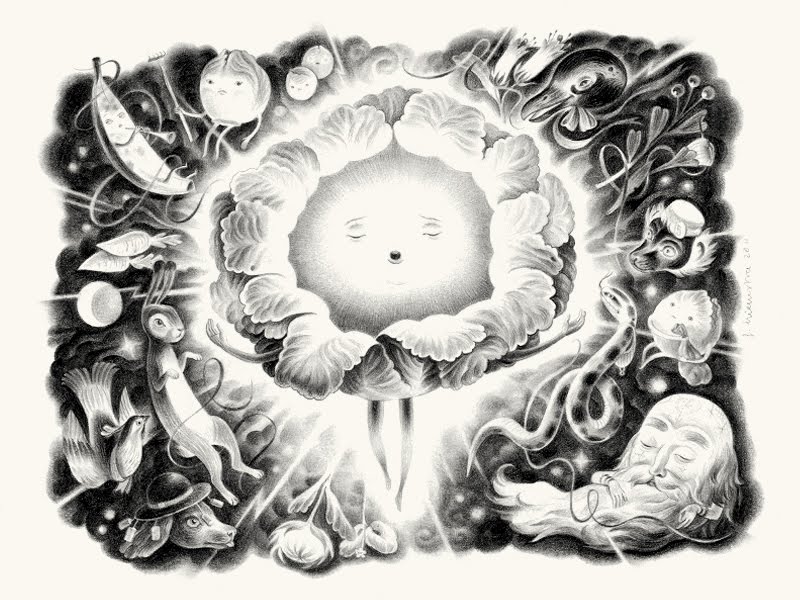
The Timid Cabbage
A Poem by Charles Krafft
Illustrated by Femke Hiemstra
(Sympathetic Press)

We rarely review children's books, but this one is so rich and subtle that it veritably demands our attention. The designers have managed to create a lovely volume you might find in a children's section of the bookstore or library sometime in the early 20th Century --- complete with generous graphite illustrations, in this case, those of Femke Hiemstra of Amsterdam. Each of the twenty-two full-page illustratons are generously given over to but a single line of the poem.And the poem? The pretense is that it is about a humble cabbage that sleeps and dreams of "banana flutes and pancake roots / and cups of hot moth tea." These odd manifestations cause the cabbage head to be chastised by the other plants in the field there next to the river:
Why don't you put your mind . . .
to something we can use
what need have we of fiddling snails
and pairs of penguin shoes?One does not have to be a rocket scientist to realize that this is a heavily symbolic poem, referring to the early sixteenth century concave set up to punish Martin Luther for his 95 Theses on the Power and Efficacy of Indulgences. The Diet of Worms is a reference to the worst enemy of the simple cabbage, Pieris rapae --- the common cabbage worm which does damage to brassica and other cabbage-family crops in fields and gardens throughout the world. In like manner, Lutheranism did immense damage to the Catholic Church. In May of 1521 a convocation (a "diet") was called at the Heylshof Garden at Worms of Rhineland-Palatinate, Germany. The convocation was designed to threaten Luther with excommunication, and thus defeat the 95 Theses.
"Snails and penguin shoes," in this charming "children's book" becomes a simalcrum of Luther's excoriation of the sales of indulgences, something as obviously fantastic (and as false) as shoes for a simple penguin (or the simple herrenvolk of Worms).
In turn "banana flutes" represent Luther's extreme opposition to holy "nepotism, simony, and usury." "Moth tea" singles out the stewardship of Pope Leo X (the lion who appears hidden in some of the gorgeous illustrations in this volume), all resulting in the inevitable growth of what we now know as the Age of Reason.
In one illustration, a bag appears next to two heads of cabbage with the word "vorrat" clearly imprinted on it. Few may know that this means "released," which would imply that Luther released northern Europeans from the locks of medieval religious thought. Indeed, his memorable if humble phrase, "Here I stand, I can do no other" could imply the good works of the humble cabbage --- yielding itself to be consumed, a simple nurturer for the simple peasants of these simple lands.
But there is yet one more evolution of the spirit that is at the heart of the symbolic scripture in The Timid Cabbage. In the concluding lines, we find a another implied "vorrat" --- one that leads us from western Christianity straight into the more gentle discipleship of eastern spiritual ways.
"I've gone to Kathmandu"
the note he left us said
there's a man up there I have to meet
whose beard is long and red..."This is as elegant a similie as one could want, for it assures us that the release from the Mother church to Protestantism and finally to the reality of the eight-fold path (represented by the exhortation to free oneself in the chains of life):
"Why don't you dream up something real
something we can see
or find yourself a cabbagette
and raise a family."At the beginning of this review, we referred to The Timid Cabbage as a children's book. Nothing could be further from the truth. It is, instead, a powerful emblem of one of the key historical events in the West --- told in such simple terms --- one that may well deceive those who cannot envision profound truths appearing in the most humble guise.